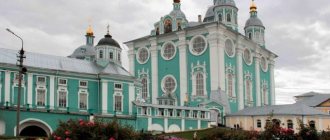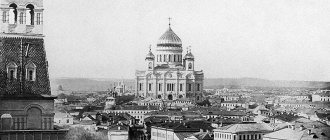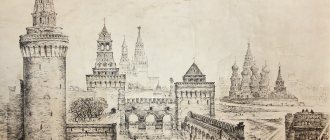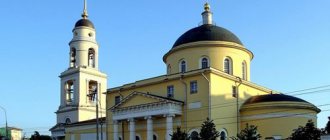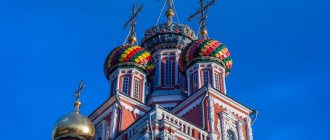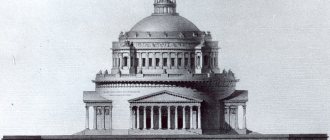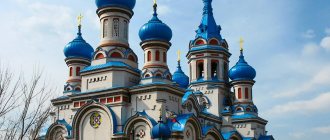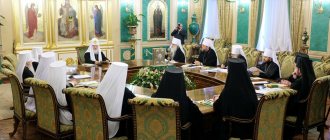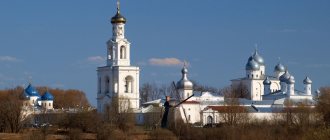History of the Assumption Cathedral
The main temple from the times of Vladimir-Suzdal Rus', in which the Moscow and Vladimir princes were married, is included in the list of UNESCO World Heritage Sites. This unique monument of the 12th century, which preserves original works by Andrei Rublev, is now a state museum-reserve.
The original temple 1158-1169
The Assumption Cathedral in Vladimir was built under Andrei Bogolyubsky, who dreamed of making it the main temple of Rus'. The church was erected not only by craftsmen from all Russian lands, but also by foreigners. The German builders were sent personally by Frederick Barbarossa. Specialists in bricklaying arrived from Kyiv, masters of white stone technology from the Dnieper region, and gilders from Greece and Galich. The location was chosen in the southern part of the city, on Klyazma.
Construction began in 1158, April 5th. The limestone building, decorated with white stone carvings, rose 5 meters higher than the St. Sophia Church in Kyiv. By 1160 the church building was completely rebuilt, and in 1161 it was painted. A quadruple covered with sheets of gilded copper rushed upward. The height of the central chapter was 32.3 meters. Entrance portals were built on three sides, the facade was decorated with complex pilasters and horizontally divided into two tiers by an arched frieze.
Those who got inside compared the magnificence of the cathedral with Solomon's Temple in Jerusalem. Gold and silver chandeliers reflected in the mosaic tiles that covered the floor. They were made of copper and colored majolica. The vaults and walls of the temple were painted with frescoes, and above the altar there was a platform for reading sermons, made of gold and silver.
Figure 1. Initial view of the Assumption Cathedral in Vladimir
Reconstruction of the cathedral in 1186-1189
In 1185, there was a fire in the city, and the Assumption Cathedral was seriously damaged. The architects restored the building, strengthening it with pylons and surrounding it with a second row of stone walls. The new "case" on the south, north and west sides was attached using arches. In addition to the resulting side galleries, the area of the altar was increased, the cathedral became more spacious (30.8 x 30 m) and had five aisles.
The restoration was carried out for 4 years by Andrei Bogolyubsky’s younger brother, Prince Vsevolod, nicknamed the Big Nest. The year of creation of the cathedral is considered to be 1158, but both brothers are buried in the northern gallery, who are revered as the creators of the shrine.
Further history of the cathedral
The long-suffering temple endured the hardships of the Mongol-Tatar invasion. The events are known when Batu, after the capture of Ryazan, rushed to Vladimir. This happened in 1238. Residents put up heroic resistance to the troops of the Tatar Khan, but were unable to hold the city. The family of Bishop Mitrofan, Princess Agafya Vsevolodovna and numerous defenders took refuge in the Assumption Cathedral. Batu gave the order to set fire to the cathedral, covering it with logs. The people inside suffered martyrdom, suffocating in the smoke.
The temple in Vladimir survived, but the walls and especially the painting were seriously damaged. Holy relics were looted and destroyed. The restoration of churches and the greatness of Rus' began after the victory on the Kulikovo Field. Prince Vasily, the son of Dmitry Donskoy, in 1408 invited two famous masters - Daniil Cherny and Andrei Rublev, who again painted the walls of the cathedral with frescoes.
In the 2nd half of the 18th century. Vladimir was visited by Catherine II, who allocated money for the renovation of the cathedral. 14 thousand rubles were spent on the iconostasis, made in the Baroque style. During the 18th–19th centuries. The appearance of the temple also underwent major changes. A bell tower with a gilded spire was built, which was connected to the cathedral by a chapel in honor of St. George the Victorious.
At the end of the XIX–XX centuries. A scientific restoration was carried out in the cathedral, as a result of which Rublev's frescoes were restored, the domes were gilded, and the white stone was cleaned. The last time the work was carried out was in the 70-80s. XX century.
Vladimir Assumption Cathedral and frescoes discovered in it
The Vladimir Cathedral Assumption Cathedral, built in 1158 by the Righteous Grand Duke Andrei Bogolyubsky and expanded in 1185 by the Grand Duke Vsevolod Georgievich, initially amazed not only our compatriots, but also foreigners with its decoration. Being entirely made of white Bulgarian stone and perfectly decorated with gold, silver and expensive stones, it was, according to the chronicle, painted in 1161 by Greek isographers, and in 1408 in the Vsevolodovs' annexes, by order of Grand Duke Vasily Dimitrievich, by famous Russian artists Daniil Ikonnik and Andrei Rublev, but over time, having experienced many serious pogroms, he lost his decorations. Gold, silver and other precious jewelry were either destroyed by fires or stolen by the Mongols and Tatars during their invasions. When the Episcopal See was closed in the city of Vladimir, and the city of Vladimir was assigned to the region of the Moscow metropolitans, the famous Bogolyubsky Cathedral fell into such desolation that, according to the chronicle, birds in large numbers built their nests in it. The Vladimir Assumption Cathedral was in poverty and desolation until the beginning of the 18th century, but for all that, its domes and walls were maintained in the same form as they were built under the Grand Dukes Andrei Bogolyubsky and Vsevolod Georgievich. From the beginning of the 18th century, when the incorrupt relics of the Holy Blessed Princes Andrei Bogolyubsky and his son Gleb were discovered in the cathedral, the ancient Russian temple began to attract the zealous attention of not only private individuals, but also the Government itself. Unfortunately, the zeal of some benefactors for the desolate cathedral church crossed the boundaries of moderation, and the beautifiers of the temple, while restoring its splendor, made changes to some of its parts. So in 1708, the steward Grigory Andreevich Plemyannikov, having renewed the iconostasis and all the icons in the cathedral, pierced and expanded the windows in the main altar, as well as the windows in the temple itself, located above the entrance to the cathedral and in some other places. In addition, to support the walls of the cathedral, he built four large buttresses. In 1727, the entire cathedral church was covered with iron rafters with Siberian iron for the amount allocated from the State Treasury in the amount of 3157 rubles, 8 altyns and 2 money: but instead of the pediment roof - a special one above each vault, a hipped one, with four slopes, and , when raising it to the middle dome, located under the gilded dome, new brick overlays were laid along all the contours on all four sides, and the windows in all five domes were bricked up by two arshins or more, depending on the rise of the roof. In 1767, EMPRESS CATHERINE II, of blessed memory, having visited the cathedral and seeing its poverty, ordered fourteen thousand rubles to be released from the treasury to restore its splendor, recommending in the highest rescript that antiquity be preserved and maintained in the best possible way. But the recommendation of the Wise EMPRESS was not fulfilled. On the contrary, when the cathedral was restored with funds granted by the Monarchy, the ancient iconostasis was broken down and with icons, and in its place a new one was installed in the Italian style with large gilded carvings and columns of all orders. The icons in it are newly painted, the painting is also Italian; the main altar was painted in place of the ancient murals in the same style as the icons in the iconostasis; then the oldest murals in the temple turned out to be no longer suitable for the character of the iconostasis, therefore the vaults, pillars and walls were replastered in some places, whitewashed in other places, and most of the ancient images and ornaments were completely knocked down, some of them were damaged and all were completely covered new plaster and whitewashed. Inside the entire cathedral there were no signs of ancient murals. At the same time, wooden frames were built in the form of tombstones on the white stone tombs in which the Grand Dukes, Duchesses and Saints were buried, and some tombs, presumably, were destroyed or lowered into the ground. After this, in later times, there were no changes in the cathedral’s decoration, only it was whitewashed with lime several times and new massive icon cases were built and installed near its pillars and walls in the style of the iconostasis. In 1861, he drew the gracious Royal attention to the ancient Assumption Cathedral in Vladimir and the late EMPEROR ALEXANDER NIKOLAEVICH. According to the most submissive report of the Minister of the Imperial Court regarding the resumption of the Assumption Cathedral in Vladimir on the Klyazma, the GOVERNMENT EMPEROR awarded with the Highest approval all the proposals of Adjutant General Count Stroganov on the resumption of the Vladimir Cathedral. From the estimate drawn up by the architect Kaminsky, it is clear that 73,229 rubles 17 kopecks were considered necessary for the restoration of the cathedral, and the restoration itself could be completed in three years. But the proposed restoration of the oldest Russian temple did not take place. The Imperial Archaeological Commission in 1871 notified His Eminence the Archbishop of Vladimir that, according to the most submissive report and review of Count Stroganov, the GOVERNMENT EMPEROR deigned to order the proposal to revive and rebuild the Assumption Cathedral to be cancelled. Thus, the Vladimir Cathedral was again destined to remain in its changed form. The cathedral was in this position until His Eminence Theognostus assumed the Vladimir See. In 1878, when the Right Reverend Theognost arrived in the city of Vladimir, the interior of the Vladimir Assumption Cathedral presented the following picture: the painting with which the main altar was decorated, in all three sections had completely fallen into disrepair; in the church itself, under the choir, it was covered with oil paint; mosquitoes located in the walls of the temple, in which the Grand Dukes, Duchesses and Saints were buried, were blocked with bricks; on the vault in the southwestern part of the temple there were facial images of Abraham, Isaac and Jacob in the Garden of Eden, discovered in 1859 by Academician Solntsev, and on the vault on the northern side by the same academician there were open ornaments in the form of large Byzantine gussets; then, in all other parts of the temple, the inside was everywhere covered with lime, which, due to dampness, especially in the side altars, did not hold firmly and crumbled. The extraordinary grandeur of the temple, preserved by God for seven centuries, with its great shrine, could not help but amaze His Eminence the Archpastor. The Reverend, indeed, paid special attention to his cathedral. He, highly appreciating its historical importance, and on the other hand, seeing its poor decoration, which did not correspond either to its extreme antiquity or its fame, immediately decided in his intention to bring the Vladimir Assumption Cathedral to its proper splendor. And the resolute Vladyka, who firmly trusted in God’s help, did not slow down in realizing his intention. Having communicated with the Moscow Archaeological Society and with the permission of the Holy Synod, Vladyka in 1880 began decorating the main cathedral altar, which was completed in 1881. After the successful completion of the decoration in the altar, the Bishop decided, at the expense of the current cathedral revenues and with the help of private donations, to decorate with ancient paintings inside the entire cathedral, as it was in times long past. Having received the proper permission, preparatory work began in the spring of 1882. When the scaffolding was laid out inside the entire cathedral, the prudent Archpastor ordered the cathedral clergy and the headman to carry out a test with special care in all parts of the temple to see if there were any other ancient frescoes anywhere other than those discovered by Academician Solntsev. Tests carried out throughout the entire cathedral were successful. In many places of the temple, partly under plaster, partly under oil paint, partly behind the icon cases and iconostasis, several facial images and ornaments are revealed, dating back to the 12th century in nature. This discovery was immediately reported to the Moscow Archaeological Society. The society, in view of the importance of the discovery, sent two deputies to examine the open frescoes on site. By the arrival of the deputies, images were open: the descent of the Holy Spirit on the Apostles - large in size, the remains of the Epiphany, the Transfiguration, the sacrifice of Joachim and Anna, the introduction of the Blessed Virgin Mary into the temple and an almost complete image on two vaults, arches and walls of the terrible second coming of Christ. Then, after that, facial images of saints and ornaments were still revealed. To prove that the open mural was made in the 12th century, the Lord helped to open two more images of the prophets, one of which was half covered with a butt made by the Grand Duke Vsevolod Georgievich in 1185. As the frescoes were discovered, members of the Moscow Archaeological Society came to the cathedral to view them, and finally, all open facial images and ornaments were recognized as worthy of all possible protection, and to guide their restoration, the Archaeological Society elected from among itself a special commission chaired by Ivan Yegorovich Zabelina. In view of such important discoveries, the rector of the cathedral, Archpriest Matvey Ivanovich Zhudro, and the lover of Christian antiquities, the cathedral elder Efim Vasilyevich Vasiliev, with the direct instructions of His Eminence Vladyka Theognost, with great caution began the task of beautifying the cathedral. From everything open in the cathedral, accurate photographs of facial images and ornaments were taken on transparent canvas and paper, in their natural size and, in addition, on a reduced scale, on Brestoll paper in the same form in which the frescoes were opened, with the damage present on them . Since with the discovery of the frescoes the nature of the murals with which the Vladimir Assumption Cathedral was decorated in ancient times became clearly evident, it was decided to restore the ancient murals inside the entire cathedral and to make additions to the damaged facial images from ancient drawings, which the Archaeological Commission recognized as more consistent with the open frescoes , located in the Staraya Ladoga St. George and Spasopereditskaya churches and in the fields of the icon of the Mother of God of Vladimir, which was once the main shrine of the Vladimir Assumption Cathedral, now located in the Moscow Assumption Cathedral. In those places where no murals were preserved at all, it was necessary to reproduce them in the same character as the open ones. The restoration and execution of the entire mural was entrusted to the icon painter of the village of Palekha, Vyaznikovsky district, Nikolai Mikhailovich Sofonov, whose sketches were approved exclusively by the Archaeological Commission. Regarding the broad and difficult task of restoring the ancient decoration in the cathedral, His Grace Theognostus could not help but see that the work of beautification he was undertaking would require enormous funds, and there are very few of them in the cathedral, but trust in the Lord God and in the help of the heavenly patrons who rest in the cathedral church , supported the energetic determination of the Archpastor, and he, having served a special prayer service in the cathedral church on February 26, on the birthday of the Most Pious GOVERNOR EMPEROR ALEXANDER ALEKSANDROVICH, together with one of the cathedral clergy, was the first in the church to sign on his own behalf a thousand rubles for the restoration of the cathedral decoration and then began to apply to persons known for piety and generosity, most earnestly asking them to assist him in his holy work with feasible donations for the decoration of the cathedral. Meanwhile, work was in full swing in the cathedral. In those places where there were no frescoes at all, the old dilapidated plaster was beaten off, and with the onset of warm spring time they began to apply new one from the best alabaster; From the mosquitoes in which the Grand Dukes, Duchesses and Saints were buried, the bricks with which the mosquitoes were buried were selected, and the damaged slabs on the white stone tombs were corrected. The restoration of the tombs to their original appearance was carried out with the greatest caution and reverent caution in the constant presence of the cathedral keymaster. It is not without interest to report in more detail about the restoration of funerary mosquitoes in the cathedral. When they took a brick from the mosquitoes located on the southern side of the cathedral, it turned out that the mosquitoes in which St. Luke was buried were sealed tightly with a large ancient brick. Behind the brick inside the mosquito on the wall above the white stone coffin, an ancient inscription was preserved: “the relics of the holy Bishop Luke of Vladimir were laid in this place in the summer ... the month of November tenth.” Around the semicircle on the wall and on the vault there was a border made of mummy, and along the bottom, above the tomb itself, with an ornament. The tomb of Bishop Luke, being tightly laid, probably in very ancient times, was preserved completely without damage, and the slab built on it on two slopes, made of whole white stone, turned out to be completely solid. This was not found on the tombs of Bishops Simon and Mitrofan. The slabs on these tombs turned out to be damaged in the very middle to the front side of the coffin and roughly covered with a thick layer of lime, which is why the stone fragments inserted into the broken place could barely hold on. To bring the tombs into the proper position, it was necessary to remove the roughly spread lime, and replace the weakly held fragments of stone embedded in the coffin slabs with neatly and firmly hewn stones. When the fragments were taken away, there were a lot of thrown stones in the coffins under the holes punched in the slabs - cobblestones, limestones, fragments of white stone, broken ice and chipped plaster. It was necessary to select everything from the tombs of the ever-memorable Saints, which the sacristan did with the assistance of the cathedral elder, finishing the job by performing a funeral litany and covering the bodies of the Saints with shrouds; After this, the damaged slabs were immediately sealed firmly on alabaster. On the relics of St. Mitrofan, signs of decayed clothing were visible in some places, and to the side in the coffin there was a broken black clay pot. The same pot was seen in the tomb of St. Simon and also a wooden comb with teeth on both sides. One could also see in this tomb several decayed clothes and leather, cut into narrow, inch-long strips. The mosquitoes located on the north side of the cathedral, in which Princes Izyaslav Andreevich and Boris Danilovich were buried, were also laid in half a brick. After clearing the tombs placed in these mosquitoes, it turned out that the slab on the coffin of Prince Izyaslav towards the front side had large cracks, covered with lime, and was barely holding on. It was necessary to take away the old one and replace it with durable white stone. When the damaged parts of the slab were removed, the relics of the Prince were clearly visible through the hole; Even durable clothing was preserved on his legs, through the fabric of which golden threads were visible. There was no garbage in this tomb, but only a lot of dried lime, which probably got there when the cracks in the slab were carelessly covered. In the coffin were also visible an iron hook, iron strips with mica, a disintegrated wooden gilded cross and several small, short bunches of red willow, on which were intact and white sprouts. On the coffin of Prince Boris Danilovich, the slab turned out to be broken, only the middle of it was intact, and at the ends there were white stones that did not fit it in size and were completely unfitted, roughly smeared with lime. It was necessary to attach the ends carefully and firmly to the middle of the slab. When the clumsy stones were taken away, it was discovered that the white stone coffin was filled almost to the very top with human bones - several skulls were visible, and one small skull was especially beautiful, all yellow, like wax, and with a very pleasant facial expression, as if smiling. After the funeral prayer was performed at these tombs of the Sovereigns and after they were covered with shrouds in both tombs, the tombstones were immediately corrected and restored to their former appearance. When clearing the tomb installed in the mosquito of the Glebovsky altar, in which the princes Mstislav, Vsevolod and Vladimir Georgievich were buried, not only the tombstone was broken, but also the right side of the coffin towards the head was damaged and sealed with brick. Through a hole in the slab, located in the very middle of it, many bones could be seen in the coffin, piled in disarray - part of an infant’s skull was visible. These bones were also covered with a shroud, and then the tomb of the Princes-martyrs was immediately put into proper order. After this, the tombs of the Grand Dukes Vsevolod Georgievich, Konstantin and Yaroslav Vsevolodovich, Prince Mstislav Andreevich the brave and Bishop Serapion were brought into proper order.
All the above-described tombs have been restored to their original form, and the mosquitoes themselves are decorated according to the model of the open mosquito in which Bishop Luke was buried. The decoration of the mosquito with ornaments was carried out by Mr. Sofonov, and his selected masters, who had mastered the style of open mural painting in the cathedral when taking photographs from the frescoes, worked diligently when painting the cathedral. It was impossible to expect the mural painters to rush into the work, because it was necessary to stop work for the winter for the reason that the cathedral church was cold: but the heavenly patron of this temple, the Blessed Prince Andrei Bogolyubsky, with other Vladimir Wonderworkers, eliminated this obstacle. By Their gracious inspiration, the cathedral patron, Mr. Vasiliev, came up with the idea of donating his capital to the heating of the cathedral church, which the previous elders were afraid to even think about, seeing the enormity of the cathedral church, and fearing the dilapidation of its seven-century walls. And this idea, with the blessing of His Eminence Archpastor Theognost, was realized so successfully that now in the massive cathedral church and
in the most severe frosts there is at least 15% heat, despite the fact that the oven is built outside the cathedral, and warm air was let into it by the skilled craftsman Mr. Mukhin only through one window. The heating device contributed to the success of mural painting. G. Sofonov was given the opportunity to carry out his work throughout the winter. Thanks to this convenience, he did a lot in the cathedral - almost the entire cathedral in the buildings of Prince Bogolyubsky was painted. Under the middle head, on the vault in the main tribune, the Savior is depicted from open in the cathedral, sitting on rainbows in a circle. Under the circle are written nine Angels - in full height - supporting the circle with their hands. All the angels are an exact copy of those located in the dome of the St. George's Old Ladoga Church - letters from the 12th century. Below the Angels above the windows, in circles ornamented according to the pattern of those open in the northwestern tribune of the cathedral, the twelve Apostles are written - all from their open images of the descent of the Holy Spirit and the second coming of Christ. Between the images of the Angels and the Apostles there is a wide border of multi-colored square checkers. Between the windows in the tribune, twelve prophets are painted in full length, of which ten are copied from Staraya Ladoga, and two are Nahum and Jonah from those opened in the cathedral on the north side of the temple. On the slopes of twelve windows there are ornaments made of ribbons, completely similar to the open remains of ornaments on the same slopes. Dominating everywhere near the facial images, near the windows, near the wide border of checkers is a strip of mummy with two narrow white stripes along its edges. Both the arrangement of the facial images and all the decorations are made completely similar to the open remains of paintings and ornaments preserved in the cathedral tribune on the north-west side. Below the tribune in four lunettes are written four Evangelists from the Gospel of the 12th century, stored in the book depository of the Moscow Synodal Printing House. On the vaults it is written again: the Nativity of the Blessed Virgin Mary, the Annunciation of the Blessed Virgin Mary, the Nativity of Christ, the Presentation of the Lord, the Resurrection of Lazarus, the Entry of the Lord into Jerusalem, the crucifixion with those to come, the Resurrection of Christ, the Assurance of St. Thomas, the Ascension of the Lord and the Dormition of the Blessed Virgin Mary. Additions were written to the open facial images: the sacrifices of Joachim and Anna, the Entry into the Temple of the Most Holy Theotokos, the Baptism of the Lord and the Transfiguration of the Lord. All of the above-mentioned images were copied from images located in the margins of the icon of the Mother of God of Vladimir, except for the Nativity of the Virgin Mary and the sacrifice of Joachim and Anna, of which the first was painted according to a special sketch from ancient images, and the second from an image located in the Church of the Savior. Fomino's assurance was copied from the icon of the ancient cathedral iconostasis located in the Trinity Church in the village of Vasilievsky, Shuisky district.
The pillars of the cathedral are almost all covered with facial images, located and ornamented in exactly the same way as those open on the pillars behind the iconostasis. All the images on the pillars were copied from the faces of kings, saints, martyrs, saints and holy women discovered in the cathedral. The entire letter is extremely characteristic and will undoubtedly attract the special attention of compatriots, and the temple itself, as a whole, will represent an example of the wonderful splendor of the church of the 12th century.
The name of His Eminence Archbishop Theognostus and his cathedral associates in the beautification of the ancient sanctuary will be unforgettable in the history of the Council; the names of Ivan Egorovich Zabelin and Vasily Egorovich Rumantsev and other members of the archaeological commission will be unforgettable for their energetic participation in restoring the ancient splendor in the seven-century-old Vladimir Cathedral; The name of Mr. Sofonov with his exemplary mural painters will also be remembered. Blessed by the Lord God will be those lovers and admirers of Russian sacred antiquity who contribute to the beautification of the famous cathedral with their donations, which the cathedral is in great need of.
Cathedral Archpriest A. Vinogradov
From No. 4, “Vlad. Eparch. Vedas" for 1884
Current state of the cathedral
Today, the cross-domed five-domed temple combines two construction stages in its appearance: the ancient three-nave core and two-tier galleries equal in area, forming two additional naves.
Figure 2. At the altar
Architecture and decoration of the cathedral
The volumetric-spatial solution of the shrine is a quadrangle with choirs that have a mosquito cover. They end with helmet-shaped chapters. The semicircular apses are on the same level with the quadrangle, the internal space of which is filled with sixteen pillars.
The facades are divided into sections by half-columns; each section of the wall also has a side-by-side end. Slit-shaped windows and moderate decoration of the two-tier facade with reliefs only emphasize the beauty of the white stone. It was also used for the foundation, which was based on several rows of cobblestones. In the architecture of the cathedral one can see a combination of classical elements (paired columns of the bell tower) and pseudo-Gothic (pointed arches). The general style of the temple is called Russian Romanesque.
What's inside
The cathedral amazes with its splendor. The chapel is decorated with sculptures of people and animals. The path to the choir of the temple lies through the staircase tower, which adjoins the western porch. The walls are smooth, but their laconicism is diluted by reliefs from the sanctuary of Andrei Bogolyubsky. On the southwestern side you can see the figures of two saints - Artemy and Abraham. They are located on the iconostasis pillars.
Inside, literally everything delights: the abundance of gold and silver, mosaic floors, wooden doors with decorative elements, ornate baroque style.
Iconostasis
This architectural structure impresses with its grandiose dimensions - its height is more than 20 meters. Having a pyramidal structure, the iconostasis is made in three tiers: local, deesis and festive. It includes 123 icons painted on linden boards with oil paints. Each is a work of art. The Deesis tier is represented by fifteen three-meter-high icons, separated by profiled belts (horizontally) and columns with pilasters (vertically).
The completion of the iconostasis is a high relief image of Hosts with eight sculptures of angels, which crown the composition from different sides. The image of the “Annunciation” with carved royal doors is also of artistic value. The carving in the form of flower garlands, acanthus leaves, grapes and pomegranate fruits is very voluminous, which creates a play of light, complemented by reflections of gold.
Figure 3. Internal splendor of the cathedral
Shrines, relics
Almost 90% of the wall paintings were made in the 19th century, but as a result of restoration, fragments of a composition belonging to Andrei Rublev were discovered and restored. This is the Last Judgment of 1408.
Important. The temple for a long time remained the place of storage of the Vladimir Icon of the Mother of God, brought by Andrei Bogolyubsky from Vyshgorod for the opening of the shrine. The icon of the hand of the Evangelist Luke, in which the Mother of God is depicted at a meal with Joseph the Betrothed and her son Jesus, was in the cathedral until 1395. Today it can be seen in the temple at the Tretyakov Gallery.
The holy relics of Andrei Bogolyubsky are kept in a separate shrine, and in the necropolis of the Assumption Cathedral you can also find the dried remains of other great princes - the younger brother of Vsevolod, Yuri Vsevolodovich, Gleb of Murom and others. Here are the burials of more than 40 representatives of the princely and bishopric classes. For these purposes, special niches are equipped in the gallery. Among the buried was Metropolitan Maxim, known for having transferred the see to Vladimir from Kyiv. This happened in 1299.
Vladimir: since the 19th century. to the present day
The frescoes decorating the main cathedral of the Vladimir diocese were restored in 1882-84. For a long time they were almost all hidden under plaster and were opened during the construction of the cathedral only in 1882.
The honor of opening these frescoes belongs to His Eminence Theognostus, now Archbishop of Novgorod. Judging by the chronicles, the cathedral was decorated with paintings several times: both in 1161 and under Vsevolod III, and finally all the painting inside the cathedral was restored in 1408 by the famous icon painter Andrei Rublev; - experts in ancient Russian art and attribute most of the fresco images discovered in the cathedral to the beginning of the 15th century. In those places where the painting was not preserved, the frescoes were painted again according to sketches approved by the Imperial Moscow Archaeological Society and compiled in the image of the Staraya Ladoga and Spas-Nereditskys near Novgorod, preserved from the 12th century. To judge how well the restoration of the fresco painting was carried out, one should compare the frescoes on the walls with exact copies of fragments exposed from under the plaster, preserved in the choir of the cathedral in frames behind glass, the accuracy of which was certified by the construction commission.
The ancient frescoes under the choir and on the western wall, depicting the Last Judgment, are especially well preserved. On the western wall above the entrance arch, the artist depicted the preparation of the throne: on the throne is the Gospel, an eight-pointed cross with a cane and a spear; at the foot of the cross there is a vessel containing the blood of the crucified God-man, which washed away the sins of the human race; righteous scales are attached to the vessel, here Adam and Eve are in a kneeling position, as the perpetrators of human sin, whose guilt was redeemed by the crucified Savior. On the sides of the throne are the Mother of God and the Forerunner, begging the Lord for mercy on sinners; behind them is one angel with rods and with the seal of the living God (Apocalypse. XXI ch.) in their hands. The continuation of the picture on both sides consists of the apostles on thrones with open books, among whom the four evangelists are recognizable by the letters inscribed on the leaves of the books; mt lk mr iw, and angels in several rows with staffs. The idea of this image is that the apostles, as the closest producers of the human salvation given in Christ, will be accomplices in the Lord’s judgment over people. The central part of this image is Christ Himself, represented on the vault between the arches, seated in a circle formed of seraphim: the austere figure of the Savior, draped in a mantle, is represented at the decisive moment of the final judgment: with his right hand the Savior makes a gesture calling the righteous to the inheritance of the kingdom prepared for them heavenly, the left expresses the rejection of sinners. Next to the Savior are the sun, the moon and the stars, established in the sky, which has the shape of a linen twisted by two angels, in accordance with the words of the psalm: “all like a robe will wear out, and like a garment, you and I will change.”
Next to the image of the Savior, symbolic figures of the four kingdoms are presented inside the arch in a circle: Macdonian - in the form of a griffin, Roman - in the form of a winged dragon, Babylonian - in the form of a bear and Antichrist - in the form of a horned beast. This is the situation of the Last Judgment.
From here the artist moves on to depicting the trial process itself. He presented two angels, one of whom trumpets down, the other up, calling the living and the dead to judgment. By the sound of these trumpets, the earth and sea give up their dead. The earth is depicted here in the form of a woman with a staff in her right hand and a coffin in her left, around her there are resurrecting figures of people in white uniform bandages, and representatives of the kingdom of animals, birds and reptiles: a lion, an elephant, a pelican, a snake. Nearby is another ancient personification - the sea, also in the form of a woman with long flowing hair: with her right hand she holds an equipped ship, next to which sea fish swim.
By the sound of the same trumpets, the faces of the holy kings are raised, presented here in the costumes of the Old Testament righteous, and in caps, and one in a diadem; the faces of the holy martyrs in robes and tunics, the faces of St. saints in cross-shaped phelonions with short hair, faces of saints in lower garments tied with wide belts, mantles and one in a hood in the form of a cap; finally the faces of the holy women...
The judgment has taken place. It is followed by the bliss of the righteous and the torment of sinners. Ap. Peter, with the key in his right hand, leads the saints to heaven; in the distance Ap. Paul, in his left hand a scroll in which is written “Come with me good people,” with his right hand points to the place of bliss of the righteous. Caption: “The saints go to heaven.” There is a prudent thief with a cross in his left hand among the trees of paradise, with the inscription “the prudent thief is the light of the evening.” The very bliss of the righteous is presented in two forms: in one place the right hand is depicted, in which there are righteous souls: apparently the artist took literally the well-known biblical expression “the righteous souls are in the hand of God”; in another place he depicted Abraham's bosom: Abraham as an old man, Isaac as a mature man, and Jacob as a rather young man are sitting on a wide dais; Abraham has in his bosom the souls of the righteous in the form of children; next to him are several more childish figures, in halos and white shirts; all around is a paradise village. The picture of paradise is complemented by the image of the Mother of God on a throne among two angels, on the wall under the arch of the southwestern part of the temple. On the left side under the arch, the angel shows the prophet Daniel, who fell in front of him, to the fulfillment of his prophecy, pointing his hand to the righteous Judge.
Interesting facts about the Assumption Cathedral
The Orthodox Church has always been active, with the exception of the post-revolutionary period. From 1917 to 1944, no services were held, but parishioners and priests managed to distinguish themselves during the Great Patriotic War and receive awards from I. Stalin. They managed to collect a huge amount of valuables, which was enough for an entire tank column.
Interesting facts are also connected with the icon of the Vladimir Mother of God, in whose reign Dmitry Donskoy and Alexander Nevsky, two outstanding Russian commanders, were married. According to legend, the shrine was lifted into the air and flown with it on an airplane around Moscow on the eve of the decisive battles for the capital. And this was done on the orders of Stalin.
Useful tips for visitors
Venerate the holy relics in Vladimir, visit a unique monument of white stone architecture of the 12th century. and a huge number of pilgrims and tourists flock to the city to defend the service. Considering that the temple is not only a museum-reserve, but also a functioning church, a number of rules should be observed:
- Do not take animals with you.
- Turn off mobile phones.
- Do not use obscene language.
- Do not smoke on the temple premises.
- Dress appropriately for visiting a holy site.
Entrance to the museum-reserve is paid, photography is prohibited.
Figure 4. Assumption Cathedral on the Klyazma River
How to get to the Assumption Cathedral in Vladimir
The bell tower on the territory of the temple is considered the geographical center of the city of Vladimir, although no one specifically calculated the distance. Address of the Assumption Cathedral: st. Bolshaya Moskovskaya, 56. It is within walking distance from the bus and train stations. You should go down the Communal Descent and turn left. Travel time will be 15-20 minutes.
Visiting mode
The temple is open to visitors six days a week: from 7-00 to 20-00. A non-working day is Monday. Group excursions are held from 13-00 to 16-45 during the break between daytime and evening services. Their schedule depends on the church calendar.
The Assumption Cathedral has gone through a lot during its history. At the same time, he continues to spiritually nourish parishioners through the Word of God. Any visitor here has the opportunity to penetrate not only the history of the Russian land, but also touch the origins of Orthodoxy.
